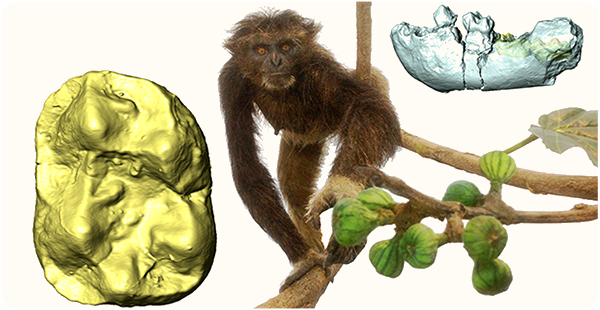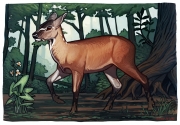In 2015, a partial skeleton with associated cranium of a small-bodied primate from Abocador de Can Mata (els Hostalets de Pierola) was described as a new genus and species, Pliobates cataloniae. Nicknamed “Laia” by the researchers, this partial skeleton corresponds to an adult female of about 5 kg that inhabited the subtropical forests from the Vallès-Penedès Basin about 11.6 million years ago. The original article revealed that Laia consumed soft fruit items and moved through the forest canopy using a combination of cautious climbing and below-branch suspensory behaviors. Also, phylogenetic analyses were performed based on morphological features from the teeth, the cranium, and the rest of the body, with the aim to decipher the closest kinship relationships of Pliobates. The results supported the view that Pliobates was a basal ape preceding the divergence between lesser (e.g., gibbons and siamangs) and great apes (orangutans, gorillas, and chimpanzees). However, subsequent phylogenetic analyses conducted by other researchers suggested instead that Pliobates is a pliopithecoid, that is, a more primitive simian preceding the divergence between Old World monkeys and apes. Admittedly, the skeleton of Pliobates displays a surprising mosaic, featuring a blend of primitive traits reminiscent of basal simians, alongside others closely resembling the modern characteristics seen in extant apes, hindering the interpretation of its kinship relationships.
Now, an international team led by the Institut Català de Paleontologia Miquel Crusafont (ICP-CERCA) has published the description of new dental remains and conducted new phylogenetic analyses of Pliobates in Nature Communications. The newly described teeth come from a different but roughly contemporaneous locality to the one that yielded the skeleton of “Laia”. The researchers employed microcomputed tomography scans not only for examining the internal morphology of teeth, specifically focusing on the enamel-dentine junction—which is not affected by dental wear—but also for digitally extracting permanent teeth that had not yet emerged from infantile individuals. “Of particular significance were the first and second lower molars that we extracted from an infantile mandible”, explains Florian Bouchet, first author of the article, which will be part of his upcoming PhD dissertation. “The shape of the lower molars holds great diagnostic value for pliopithecoid primates, primarily due to the presence of a distinctive structure termed the 'pliopithecine triangle'”, adds the researcher. This triangle comprises a small basin flanked by two crests, distinguishing pliopithecoids from other primates.
“The results of the study conclusively indicate that Pliobates is a derived crouzeliid pliopithecoid, most closely related to poorly-known and similarly small-bodied genera such as Plesiopliopithecus and Crouzelia, which have been recorded in elsewhere in Europe”, explains the lead senior author of the paper and ICP Director, David M. Alba. Notably, the phylogenetic analyses integrating the new dental data unequivocally support the crouzeliid status of Pliobates. However, the phylogenetic relationships reconstructed for pliopithecoids as a whole vary significantly depending on the anatomical regions considered. Thus, craniodental characteristics support pliopithecoids as a clade of stem catarrhines, that is, as a group that includes all the descendants from a last common ancestor that diverged before the split between Old World monkeys and apes. In contrast, the inclusion of postcranial characteristics reconstructs pliopithecoids as more closely related to apes and humans. This is attributable to the possession by Pliobates of multiple postcranial features convergent with those of modern apes, thus strengthening the contention that such features might also have independently evolved among various ape lineages due to adaptation for climbing and/or suspensory behaviors.
In summary, the results support the stem catarrhine status of Pliobates as a derived pliopithecoid, that exhibits convergent traits with extant hominoids. This notwithstanding, Pliobates remains highly pertinent for elucidating hominoid evolution. On the one hand, it nicely illustrates the plausibility of similar postcranial features independently evolving owing to similar selection pressures. On the other, Pliobates has been reconstructed as an arboreal cautious climber further displaying important quadrupedal and suspensory components in its locomotor repertoire. Consequently, it can be considered a suitable model for elucidating the intermediate phases in the evolutionary transition from quadrupedal to climbing/suspensory apes during hominoid evolution.
The exceptional paleontological macrosite of the Can Mata landfill
The macrosite of Abocador de Can Mata, in the fossiliferous area of els Hostalets de Pierola (Catalonia, NE Iberian Peninsula), is one of the most important worldwide to study Miocene primates. The paleontological surveillance performed during the enlargement of the landfill over the last two decades, under the scientific supervision of researchers linked to the ICP, has enabled the recovery the recovery of thousands of fossil vertebrate remains from 12.6 to 11.1 Ma, including some extraordinary primate skeletons remains. Besides Pliobates, most noteworthy are the skeleton of Pierolapithecus catalaunicus (known as “Pau”), found in 2002 and described in 2004, as well as the skull of Anoiapithecus brevirostris (“Lluc”), described in 2009.
During the late Middle and early Late Miocene, the area where the current landfill is located was a closed forest with a warm and wet climate with sporadic permanent waterbodies nearby. This environment hosted a considerable faunal diversity, including about 80 mammalian species that have been identified at the site, in addition to amphibians, reptiles and birds. Thus, besides hominoid and pliopithecoid primates, small mammals (insectivorans and rodents), ungulates (such as horses, rhinos, and deer), many carnivorans (including false saber-toothed cats, currently extinct), and proboscideans distantly related to modern elephants have been found in this area.
Main Image: Reconstruction of the life appearance of Pliobates cataloniae elaborated by Quagga (currently on display at the ICP Museum in Sabadell), surrounded by the new infantile mandible with the permanent molars in semitransparency (right) and occlusal view of the digitally extracted lower first molar showing the distal arm of the pliopithecine triangle (left), not to scale. Photograph by D.M. Alba and digital renders by Florian Bouchet, © ICP
Original research article:
- Bouchet, F., Zanolli, C., Urciuoli, A., Almécija, S., Fortuny, J., Robles, J. M., Beaudet, A., Moyà-Solà, S., & Alba, D. M. (2024). The Miocene primate Pliobates is a pliopithecoid. Nature Communications, 15, 2822. https://doi.org/10.1038/s41467-024-47034-9















